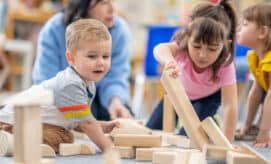Infancy is an exciting time of rapid development. During this early learning stage, little ones make new discoveries and achieve new milestones every day!
In infant classrooms, educators have an opportunity to support this growth by offering high-quality environments that are stimulating, engaging, and developmentally-appropriate. Creating these spaces requires thoughtful care, planning, and consideration of the way that infants learn as they observe the world around them. In this article, we share tips and resources designed to help infant care and learning providers create high quality learning environments that support infant development, growth, and learning.
What is a High Quality Early Learning Environment?
In the early learning field, the phrase “high quality” is often used to describe classrooms and curriculum. But, what do these words actually mean? What makes an early learning environment “high quality”? A high quality learning space requires thoughtful planning and carefully curated materials and learning centers designed to support the developmental progress of the children playing and learning there. High quality early learning spaces include elements that stimulate and engage children’s natural sense of exploration and inclination towards learning through play.
According to NAEYC, high quality early learning spaces feature:
- Nurturing Relationships. Educators establish positive, nurturing relationships with children to encourage each child’s sense of belonging as part of the classroom community.
- Culturally Responsive Spaces. Educators consider each child’s development, culture, and home language to create an environment that reflects the diversity of the community.
- Healthy and Safe Environments. The program’s facilities, equipment, and materials are well-maintained to ensure each child’s health and safety while supporting developmental progress.
- Collaboration with Families. Educators establish and maintain collaborative relationships with each child’s family to foster children’s development in all settings.
How to Create a High Quality Learning Space for Infants
High quality infant learning spaces share the same qualities as those found in high quality classrooms for toddlers and preschoolers. Following are some suggestions for adapting program and classroom spaces to infant learning needs and developmental milestones.
Put Relationships at the Forefront
During children’s early years, learning happens in the context of relationships. Little ones experience and learn about the world through interactions with their adult caregivers. An article from the Center on the Developing Child at Harvard University notes that “The quality and stability of a child’s human relationships in the early years lay the foundation for a wide range of later developmental outcomes that really matter…relationships are the ‘active ingredients’ of the environment’s influence on healthy human development. They incorporate the qualities that best promote competence and well-being – individualized responsiveness, mutual action-and-interaction, and an emotional connection to another human being.”
We can build relationships with infants by engaging in back-and-forth communication, singing or listening to music together, reading books together, and responding to their cues when they let us know that they are hungry, tired, or uncomfortable. When we emphasize the relationship with the infants in our care, we help them to feel a sense of security that ultimately encourages them to feel safe as they play and explore in the classroom.
Create Space to Safely Explore
Throughout the infant stage of development, little ones transition through a variety of kinds of movement. They begin to move about their environment by rolling, later transitioning to crawling, standing, and ultimately taking their first steps. All of these different kinds of movement require safe, soft spaces that give little ones lots of opportunity to move around.
Consider your infant classroom and see if there are open spaces with soft rugs or cushions nearby that encourage children to roam about and move their bodies! This supports their growth in a variety of ways – from strengthening physical development as they engage large muscles in their arms and legs to promoting their sense of curiosity as they explore the room and find new things that they are interested in discovering!
Incorporate a Variety of Textures






